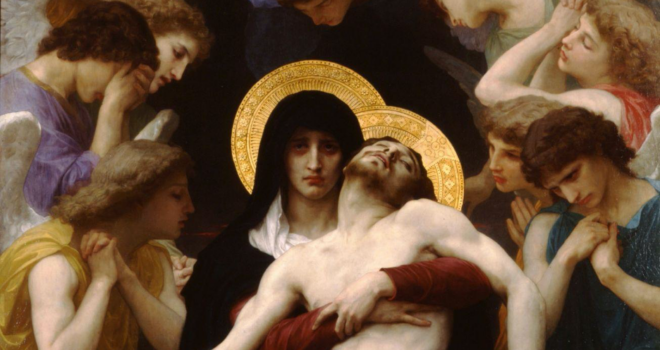During childhood, our mothers would often advise us to “offer it up” whenever we complained about small inconveniences and sufferings. Little did we realize that this simple phrase held the key to understanding the profound mystery of Co-redemption. As an oncologist, I’ve had the opportunity to delve deeper into this concept, looking beyond the physical veil of suffering and pain to grasp the profound spiritual reality that often goes unnoticed. It has been a journey of enlightenment and appreciation, shedding light on Our Lady’s co-redemption and how we actively participate in it.
The Lord Jesus proclaimed, “for I was hungry and you gave me food, I was thirsty and you gave me drink, I was a stranger and you welcomed me, I was naked and you clothed me, I was sick and you visited me, I was in prison and you came to me.” (Matthew 25:35-36)
In identifying Himself with the suffering patient, the Lord Jesus conveys that He is one with those in affliction. What consolation it is to know that we share in Christ’s dignity when we suffer! When we are sick or ill, we are united with Christ, sharing in His suffering just as He shares in ours. This connection is forged as we align our pain and trials with Christ’s redemptive passion on the Cross at Calvary. Our faith in the Lord Jesus Christ empowers us to endure the challenges of seeking medical assistance, whether curable or not. Despite the physical and emotional toll of sickness, through our faith, we offer our pain and suffering to Christ, enabling us to participate in the salvation of souls through the merits of our united suffering.
In our suffering, we can also turn to the Blessed Mother Mary. At the foot of the Cross, Mary stood as a source of consolation and strength for Jesus. She cradled Him in her arms when His lifeless body was taken down from the cross – a poignant image known as the Pieta. This moment encapsulates the profound union of Mary’s extreme sorrow and Jesus’ salvific wounds. In our own suffering, we too are linked to Mary, as we are joined with Christ, wounded and breathless, in the comforting embrace of His mother.
Simeon prophesied, “and a sword will pierce through your own soul also.” (Luke 2:35). Truly, the sorrowful sword is vividly manifested at the foot of the Cross. The spear that pierced Jesus’ heart also pierced the soul of Mary. She, our co-Redemptrix, embraced the divine will of her Son and her God, consenting out of love.
Again, the Lord Jesus said: For… I was hungry and you gave me food, I was thirsty and you gave me drink, I was a stranger and you welcomed me, I was naked and you clothed me, I was sick and you visited me, I was in prison and you came to me.” These words of Jesus apply perfectly to our Mother Mary Most Holy. Jesus was hungry, and Mary not only fed Him in her function as a mother, but also she fed Him with her obedience to the salvific plan of incarnation and passion and resurrection. Jesus was and is hungry for souls that are willing to surrender everything to Him so that those souls will be united with the Will of God (“Thy will be done” – Matthew 6:10) so that God’s designs will save more souls through us. Mary represents the perfect example of feeding Jesus’ “hunger for righteousness” (Matthew 5:6) with her obedience and surrender to the Will of God.
Jesus was thirsty, and Mary not only gave Him drink during His childhood and on His preaching journeys, but also, as He suffered on the Cross, He said “I thirst” (John 19:28). His thirst was to love us ever more fully and to receive our love in return. Mary stood steadfastly at the foot of the Cross, despite almost all the disciples deserting Him. She remained there out of her profound love for her Son and her God.
To the world, it was a strange idea that the Son of God would become a baby. Yet, Mary welcomed Jesus when she carried Him in her womb during the mystery of the Incarnation. This act of divine acceptance challenged human reason, yet this stranger whom Mary welcomed was the Son of God, the Savior of the world. On the Cross, Jesus, adorned with disfiguring wounds, became a stranger covered in blood, bearing the sins of humanity. In this moment, Mary once again welcomed this stranger, staying at His feet, praying, and uniting her suffering with His. We, too, welcome Jesus in our hearts in the Eucharist. Jesus in the Eucharist is a stranger in the eyes of non-believers, yet in His very own words: This is my Body… This is my Blood… In our own suffering, when we are united with Christ, especially through the Eucharist, we become strangers to the world and our former lives, yet Mary welcomes us into her compassionate embrace.
Just as Mary swaddled Jesus when He was born naked, she also covered His naked body with reverent tears after being taken down from the Cross. She enshrouded His holy body with the burial cloth. When we are sick, and when we unite ourselves with the Passion of Christ, our lack of health, so to speak, our nakedness is covered by the spiritual merits of the suffering of Jesus and Mary.
In Jesus’ affliction, depicted as a leper cast out on Calvary, Mary faithfully stood at the foot of the Cross, caring for Him. His body, covered from head to toe with cruel wounds like a leper, bore the weight of our sins. As we unite our own sufferings with Christ, Mary intercedes for us with her prayers. She presents our suffering, united with His Passion, to God the Father, seeking atonement for our sins and those of the entire world.
Before His crucifixion, Jesus was arrested and imprisoned. As described in the Gospels, Jesus was taken prisoner by temple guards in the Garden of Gethsemane after being betrayed by Judas (Mark 14:43-46). He was brought before the Sanhedrin and Pontius Pilate, falsely accused, and sentenced to death though no crime was committed (Luke 22:63-71, Luke 23:1-25). After enduring torture and mockery, Jesus carried His cross to Calvary where He was crucified between two criminals (Luke 23:26-43). His body was then laid in a tomb guarded by soldiers for three days before rising again in resurrection victory (Matthew 27:62-66).
During those times of unjust imprisonment and confinement in death’s dark tomb, Mary prayed unceasingly for Him, never wavering in her hope and belief in His resurrection.
Similarly, when we face moments of physical confinement and imprisonment due to illness, when our bod-les are limited in their movements, Mary comes to comfort us. Through her constant prayers and unwavering faith in the resurrection of her Son, she bestows upon us the grace to persevere. She intercedes for us to obtain the gifts of the Holy Spirit which guide us on our journey. These invaluable blessings through Mary sustain us as we seek to attain Heaven and eternally experience the Beatific Vision of the Holy Trinity. Just as she prayed unceasingly for Jesus in His times of trial, she prays for us in our illnesses and distresses. Her faith remains our anchor, and her graces propel us toward our heavenly home.
Through sickness and suffering, we are intimately united with Christ in His Passion. As we embrace our trials and align our pains with His redemptive sacrifice, we become one with Him on the Cross at Calvary. In our moments of affliction, we can seek the consolation and intercession of our Blessed Mother Mary, our co-Redemptrix, who suffered alongside her Son. Mary welcomes us into her maternal embrace as we unite our hardships with Jesus’ Passion, covering us with her prayers. United with Christ and comforted by Mary, we can find meaning and grace in our suffering. As we hold tight to the rosary in our hands and meditate on the mysteries of the rosary in our minds, we open ourselves to the graces that flow from walking more closely with Jesus and Mary in our sickness. And in our final illness, we can receive the viaticum, the Eucharist as food for our journey to eternal life, which strengthens us and fills us with Christ’s enduring love. Though illness brings challenges, it also brings us closer to Christ and opens the door to salvation if we follow Mary’s example of unwavering faith, hope, and love.
This article was originally featured in Missio Immaculatae Volume 19/No. 5, September/October 2023 under the pen name of Elio P. Mio. Missio Immaculatae is a bimonthly Marian catechetical-missionary magazine of the Academy of the Immaculate. (https://missiomagazine.com/)












